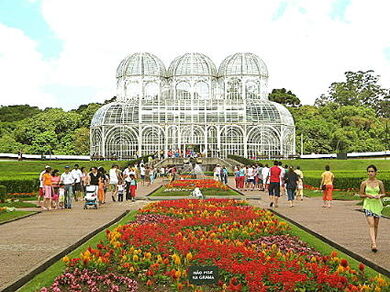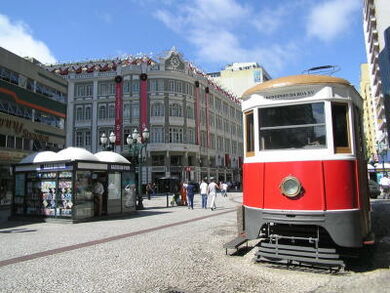
Botanical Garden of Curitiba, Photo credit: Mayra Felício Terzian
Curitiba is the capital city of the Brazilian state of Paraná. In 2005 its population was approximately 1,757,904 people. Its metropolitan area comprises 26 municipalities with a total population of over 3.2 million (2006 IBGE estimate). Curitiba is the largest and one of the most important cities of Southern Brazil, being a cultural, political and economic center. Curitiba is often cited as an example of urban sustainability.
Topic links[]
The headings in this section provide links to some of the topics in the Ideas Bank. Click on the Ideas Bank link, or the category listing to see a full list of topics.
Curitiba is a particpant of the United Nations Environment Programme's Climate Neutral Network
Urban Planning
Curitiba has a master planned transportation system, which includes lanes on major streets devoted to a bus rapid transit system. The buses are long, split into three sections (bi-articulated), and stop at designated elevated tubes, complete with disabled access. The system, used by 85% of Curitiba's population, is the source of inspiration for the TransMilenio in Bogotá, Colombia, as well as the Orange Line of Los Angeles, California, and for a future transportation system in Panama City, Panama. The city has also paid careful attention to preserving and caring for its green areas, boasting 54 m² of green space per inhabitant.
In the 1940s and 1950s, Alfred Agache, cofounder of the French Society for Urban Studies, was hired to produce the first city plan. It emphasised a star of boulevards, with public amenities downtown, an industrial district and sanitation. It was followed when possible, but was too expensive to complete.
By the 1960s, Curitiba's population had ballooned to 430,000, and some residents feared that the growth in population threatened to drastically change the character of the city. In 1964, Mayor Ivo Arzua solicited proposals for urban design. Architect Jaime Lerner, who later became mayor, led a team from the Universidade Federal do Paraná that suggested strict controls on urban sprawl, a reduction of traffic in the downtown area, preservation of Curitiba's Historic Sector, and a (supposedly) convenient and affordable public transit system.

November 15 Street, one of the major streets of Curitiba, transformed in a pedestrian-exclusive street in 1972.
This plan, known as the Curitiba Master Plan, was adopted in 1968. Lerner closed XV de Novembro St. to vehicles, because it had very high pedestrian traffic. The plan had a new road design to minimise traffic: the Trinary Road System. This uses two one-way streets moving in opposite directions which surround a smaller, two-lane street where the express buses have their exclusive lane. Five of these roads form a star that converges to the city centre. Land farther from these roads is zoned for lower density developments, to reduce traffic away from the main roads. A number of areas subject to floods were condemned and became parks.
Today, Curitiba is considered one of the best examples of urban planning world-wide. In June 1996, the chairman of the Habitat II summit of mayors and urban planners in Istanbul praised Curitiba as "the most innovative city in the world."
In the 1980s, the RIT (Rede Integrada de Transporte, Integrated Transport Network) was created, allowing transit between any points in the city by paying just one fare. At the same time, the city began a project called the "Faróis de Saber" (Lighthouses of Knowledge). These Lighthouses are free educational centers which include libraries, Internet access, and other cultural resources. Job training, social welfare and educational programs are coordinated, and often supply labor to improve the city's amenities or services, as well as education and income.
Related[]
|
|
|
| This page uses Creative Commons Licensed content from Wikipedia (view authors). |